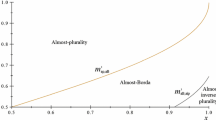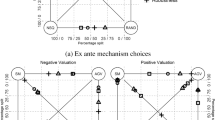Abstract
In many group decision-making situations, such as faculty hiring decisions, outcomes are often arrived at by deciding one issue at a time (e.g., first rank, then subfield). It is well known that procedures limiting votes to separate orthogonal dimensions always result in a unique outcome at the generalized median, the median of each separate issue dimension. Often, however, there is conflict within groups over what ought to be the relevant (orthogonal) dimensions within which choices will be made. We show that the way in which debate is structured (i.e., the way in which the dimensions of choice are specified) can have important consequences for what outcome gets chosen. However, we also show that the range of outcomes that could arise from alternative structurings of the decision process is bounded. These bounds are expressed relative to the yolk, a sphere located centrally in the Pareto set, whose existence was first noted by Tullock (1967: 262) and whose properties have recently been developed by McKelvey (1986) and Feld et al. (1987). We find that, in m orthogonal dimensions, the feasible outcomes must lie within % MathType!MTEF!2!1!+-% feaafiart1ev1aaatCvAUfeBSjuyZL2yd9gzLbvyNv2CaerbuLwBLn% hiov2DGi1BTfMBaeXatLxBI9gBaerbd9wDYLwzYbItLDharqqtubsr% 4rNCHbGeaGqiVu0Je9sqqrpepC0xbbL8F4rqqrFfpeea0xe9Lq-Jc9% vqaqpepm0xbba9pwe9Q8fs0-yqaqpepae9pg0FirpepeKkFr0xfr-x% fr-xb9adbaqaaeGaciGaaiaabeqaamaabaabaaGcbaWaaOaaaeaaca% qGTbaaleqaaaaa!36F8!\[\sqrt {\text{m}} \] radii of the center of the yolk
Similar content being viewed by others
References
Adams, W., and Yellen, J. (1976). Commodity bundling and the burden of monopoly. Quarterly Journal of Economics 90 (August): 475–498.
Banks, J.S. (1985). Sophisticated voting outcomes and agenda control. Social Choice and Welfare. 1: 4: 295–306.
Black, D. (1958). The theory of committees and elections. Cambridge: Cambridge University Press.
Black, D., and Newing, R.A. (1951). Committee decisions with complementary valuation. London: William Hodge.
Davis, O.A., DeGroot, M.H., and Hinich, M.J. (1972). Social preference orderings and majority rule. Econometrica 40.I: 147–157.
Denzau, A.T., and MacKay, R.J. (1981). Structured-induced equilibrium and perfect-foresight expectations. American Journal of Political Science 25 (November): 762–779.
Denzau, A.T., and MacKay, R.J. (1983). Gatekeeping and monopoly power of committees: An analysis of sincere and sophisticated behavior. American Journal of Political Science 27 (November): 740–761.
Farquharson, R. (1969). Theory of voting. New Haven, CT: Yale University Press.
Feld, S.L., and Grofman, B. (1987). Necessary and sufficient conditions for a majority winner in the spatial context: An intuitive geometric approach. American Journal of Political Science 31 (November): 709–728.
Feld, S.L., Grofman, B., and Miller, N. (1989 forthcoming). Limitations of agenda manipulation in the spatial context. Mathematical Modelling.
Feld, S.L., Grofman, B., Hartley, C., Kilgour, M., and Miller, N. (1987). The uncovered set in spatial voting games. Theory and Decision 23: 129–156.
Feld, S.L., Grofman, B., and Miller, N. (1989 forthcoming). Centripetal forces in spatial voting games: On the size of the yolk. Public Choice.
Ferejohn, J.A., McKelvey, R.D., and Packel, E.W. (1984). Limiting distributions for continuous state Markov models. Social Choice and Welfare 1: 45–67.
Grofman, B. (1969). Some notes on voting schemes and the will of the majority. Public Choice 7 (Winter): 65–80.
Grofman, B., and Uhlaner, C. (1985). Metapreferences and the stability of group decision making: Thoughts on broadening and changing the debate. Theory and Decision 19: 31–50.
Kadane, J.B. (1972). On division of the question. Public Choice 13 (Fall): 47–54.
Kramer, G.H. (1973). Sophisticated voting over multidimensional choice spaces. Journal of Mathematical Sociology 2 (2): 165–181.
Krehbiel, K. (1984, January). Obstruction, germaneness and representativeness in legislatures. Social Science Working Paper 510: 1–37, California Institute of Technology.
MacKay, R.J., and Weaver, C.L. (1979). Commodity bundling and agenda control in the public sector: A mathematical analysis. Working Paper, VPI Center for the Study of Public Choice.
McKelvey, R.D. (1979). General conditions for global intransitivities in formal voting models. Econometrica 47: 1085–1111.
McKelvey, R.D. (1986). Covering, dominance and institution free properties of social choice. American Journal of Political Science 30: 283–314.
McKelvey, R.D., and Niemi, R.G. (1978). A multistage game representation of sophisticated voting for binary procedures. Journal of Economic Theory 18: 1–22.
Miller, N.R. (1977). Graph-theoretical approaches to theory of voting. American Journal of Political Science 21 (4): 769–803.
Miller, N.R. (1980). A new ‘solution set’ for tournaments and majority voting. American Journal of Political Science 24: 68–96.
Miller, N.R. (1983). The covering relation in tournaments: Two corrections. American Journal of Political Science 27 (May): 382–385.
Moulin, H. (1984). Choosing from a tournament. Social Choice and Welfare 3: 271–291.
Niemi, R.G., McKelvey, R., and Bjurulf, B. (1974, June). Strategic voting: Some new results and some questions. Paper presented to the Conference on Mathematical Models of Congress, Aspen, CO.
Plott, C.R. (1967). A notion of equilibrium and its possibility under majority rule. American Economic Review 57: 787–806.
Plott, C.R., and Levine, M.E. (1978). A model of agenda influence on committee decisions. American Economic Review 68: 146–160.
Riker, W.H. (1982). Liberalism v. populism. San Francisco: Freeman.
Riker, W.H. (1984). The heresthetics of constitution-making, the Presidency in 1787, with comments on determinism and rational choice. American Political Science Review 78: 1–16.
Romer, T., and Rosenthal, H. (1978). Political resource allocation, controlled agendas, and the status quo. Public Choice 33 (4): 27–43.
Romer, T., and Rosenthal, H. (1979). Bureaucrats vs. voters: On the political economy of resource allocation by direct democracy. Quarterly Journal of Economics 93: 563–588.
Schattschneider, E.E. (1942). Party government, New York: Farrar and Rinehart.
Schattschneider, E.E. (1968). The semi-sovereign people. New York: Holt, Rinehart.
Schofield, N. (1978). Instability of simple dynamic games. Review of Economic Studies 45: 575–594.
Shepsle, K.A. (1979a). Institutional arrangements and equilibrium in multidimensional voting models. American Journal of Political Science 23 (February): 27–59.
Shepsle, K.A. (1979b). The role of institutional structure in the creation of policy equilibrium. In D.W. Rae and T.J. Risemeir (Eds.), Public policy and public choice VI: 249–282. Beverly Hills: Sage.
Shepsle, K.A. (1986). The positive theory of legislative institutions: An enrichment of social choice and spatial models. Public Choice 50: 133–178.
Shepsle, K.A. and Weingast, B.R. (1984). Uncovered sets and sophisticated voting outcomes with implications for agenda institutions. American Journal of Political Science 28.1 (February): 49–74.
Sullivan, T. (1985). Procedural structure: Success and influence in Congress. New York: Praeger
Tullock, G. (1967). The general irrelevance of the general impossibility theorem. Quarterly Journal of Economics 81: 256–270.
Author information
Authors and Affiliations
Additional information
The listing of authors is alphabetical. We are indebted to Nicholas Miller for helpful suggestions; to Leslie Lindzey, Gerald Florence, Helen Wildman, and the staffs of the Word Processing Centers, School of Social Sciences, UCI, and the Center for Advanced Study in the Behavioral Sciences, Stanford, for manuscript typing; to Cheryl Larsson and Deanna Knickerbocker for preparation of figures; and to Dorothy Gormick and Wendy Fan for bibliographic assistance. The second-named author would also like to acknowledge gratitude to Ted Lowi, who, many years ago, introduced him to the work of E.E. Schattschneider. This research was in part supported by a grant from The National Science Foundation, SES# 85-06376, Decision and Management Science Program, of which the second-named author is Co-Principal Investigator, and by NSF Grant # BNS-8011994 to the Center for Advanced Study in the Behavioral Sciences, at which the second-named author was a Fellow in 1985–86 while this research was begun. When this work was begun, the first-named author was a Visiting Associate Professor of Sociology at Dartmouth.
Rights and permissions
About this article
Cite this article
Feld, S.L., Grofman, B. Majority rule outcomes and the structure of debate in one-issue-at-a-time decision-making. Public Choice 59, 239–252 (1988). https://doi.org/10.1007/BF00118538
Issue Date:
DOI: https://doi.org/10.1007/BF00118538




